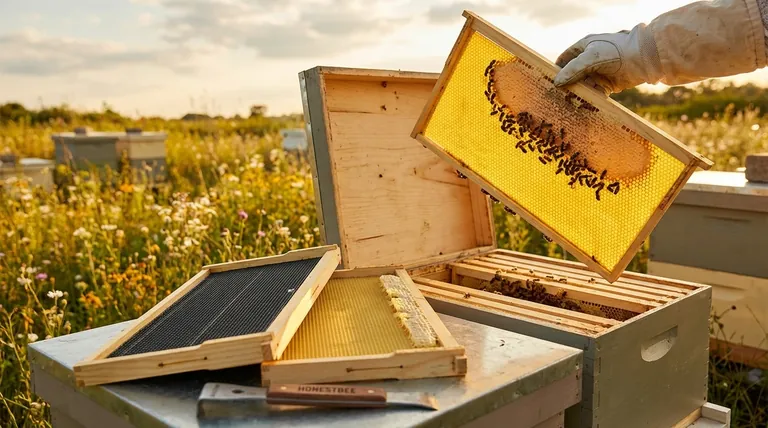At its core, a frame is a removable rectangular structure that hangs inside a Langstroth beehive box. It is the single most important component for modern beekeeping, as it provides the scaffolding upon which bees build their entire world of honeycomb for raising young and storing food.
The Langstroth frame is not just a piece of wood; it is the invention that allows a beekeeper to inspect, manage, and harvest from a hive without destroying the colony's delicate wax comb. Understanding the frame is understanding the foundation of modern hive management.

The Frame's Role in the Modern Beehive
The genius of the Langstroth hive design is the precise spacing it maintains around every frame. This "bee space" prevents bees from gluing the frames to the hive walls, making them removable.
Anatomy of a Frame
A standard frame is a simple but critical assembly. It consists of four wooden pieces: a top bar, two side bars, and a bottom bar.
The top bar is wider than the rest of the frame and features extended "ears" on each end. These ears rest on a recessed ledge, called a rabbet, inside the hive body, allowing the frame to hang freely.
The side bars provide the vertical structure, and the bottom bar completes the rectangle, adding stability. Some side bars have pre-drilled holes, which allow the beekeeper to run wire through the frame for added support.
A Foundation for the Colony
Frames are rarely placed into a hive completely empty. They typically include a sheet of foundation, which gives the bees a guide for building straight, orderly comb.
Foundation is a thin sheet of either beeswax or food-grade plastic that is embossed with a hexagonal cell pattern. This encourages bees to build the comb exactly where the beekeeper wants it, preventing a chaotic mess of cross-comb and making inspections possible.
Understanding the Trade-offs: Foundation Choices
A beekeeper must decide what, if anything, to put inside their frames. This choice has a direct impact on the colony and the beekeeper's management style.
The Case for Wax or Plastic Foundation
Using foundation is the most common practice, especially for new beekeepers. It provides a clear blueprint for the bees, ensuring they build straight, even comb that is easy to remove and inspect.
Plastic foundation is extremely durable and less prone to damage during honey extraction. Wax foundation is more readily accepted by some colonies but is more fragile. Both ensure the bees build uniform cells, which is ideal for maximizing honey storage.
The Case for Going Foundationless
Some beekeepers prefer "foundationless" frames. These frames are empty except for a small wooden guide or a strip of wax along the top bar.
This approach allows bees to build comb in a more natural way, creating cell sizes of their own choosing for workers, drones, and honey storage. While it requires more diligent monitoring to prevent messy cross-comb, many feel it is a more bee-centric practice.
Making the Right Choice for Your Goal
Your choice of frame setup should align directly with your beekeeping philosophy and objectives.
- If your primary focus is maximizing honey production: Use plastic or wax foundation to encourage fast, uniform comb construction for efficient honey storage.
- If your primary focus is natural beekeeping: Use foundationless frames to give bees control over their comb architecture and cell size.
- If you are a new beekeeper seeking simplicity: Start with foundation to ensure your hive remains manageable and your frames are structurally sound.
Mastering the function and options of the hive frame is the first step toward becoming a confident and effective beekeeper.
Summary Table:
| Frame Component | Function |
|---|---|
| Top Bar | Hangs on the hive's rabbet; features 'ears' for support. |
| Side Bars | Provide vertical structure; may include holes for wiring. |
| Bottom Bar | Completes the rectangle, adding stability to the frame. |
| Foundation | A guide (wax or plastic) for bees to build straight honeycomb. |
Ready to build a stronger, more productive apiary? The right frames are the foundation of a successful hive. At HONESTBEE, we supply high-quality, durable beekeeping frames and equipment in bulk to commercial apiaries and distributors. Our wholesale-focused operations ensure you get the reliable supplies you need to scale your business efficiently. Let's discuss how our products can support your beekeeping goals. Contact our wholesale team today for pricing and to place your order!
Visual Guide

Related Products
- Professional In-Hive Bee Feeder HONESTBEE Frame for Beekeeping
- Professional Bee Frame Wiring Tool with Integrated Tensioning System by HONESTBEE
- 3.5L Plastic Beehive Frame Feeder Deep Frame Water Feeder for In Hive Use
- Assembled Wooden Bee Frames with Beeswax Foundation Ready to Use by HONESTBEE
- HONESTBEE Wired and Assembled Wooden Bee Frames Foundation for a Thriving Hive
People Also Ask
- What are the two most popular types of honey bee feeders? A Guide to Frame and Bucket Feeders
- What are the advantages of using frames in a Langstroth hive? Achieve Superior Hive Management and Honey Production
- How do I keep bees from drowning in my frame feeder? Essential Tips for a Safe Hive
- Are frame feeders good? Maximize Your Hive's Health with the Right Feeding Strategy
- Where should a bee feeder be placed? The Essential Guide to Hive Safety & Efficiency



















